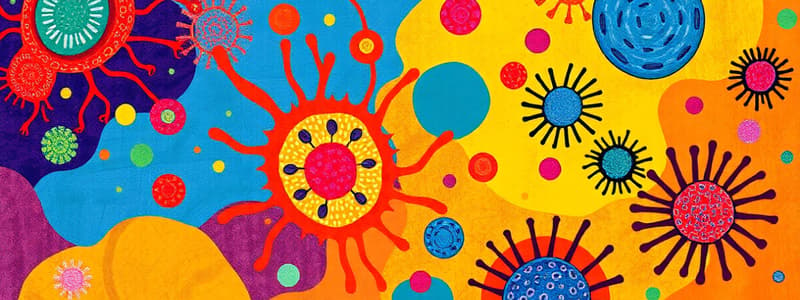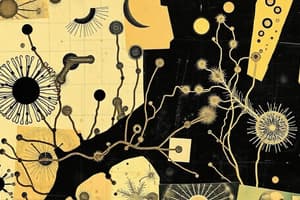Podcast
Questions and Answers
According to the content, how would microbiology be defined?
According to the content, how would microbiology be defined?
- The branch of biology focused on the study of the human body.
- The study of organisms and acellular entities too small to be clearly seen by the unaided eye. (correct)
- The comprehensive analysis of plant life and their environmental impact.
- The study of all living organisms, regardless of size.
Which characteristic is most pertinent when classifying something within the scope of microbiology?
Which characteristic is most pertinent when classifying something within the scope of microbiology?
- Exclusively multicellular organisms.
- Organisms visible only with advanced imaging systems.
- Primarily organisms that are pathogenic.
- Size, requiring the aid of magnification for clear observation. (correct)
In what context does the provided material define microbiology?
In what context does the provided material define microbiology?
- The study of interactions between large organisms and their environment.
- The study of all microscopic entities, including both cellular and acellular forms. (correct)
- The study of macroscopic organisms and their evolutionary history.
- The study of cellular organisms exclusively.
Which of the following falls under the purview of microbiology, based on the information?
Which of the following falls under the purview of microbiology, based on the information?
What key attribute distinguishes microbiology from other fields of biology?
What key attribute distinguishes microbiology from other fields of biology?
Flashcards
Microbiology
Microbiology
The study of microscopic organisms and acellular entities.
Microorganisms
Microorganisms
Organisms too small to be seen by the naked eye.
Acellular entities
Acellular entities
Non-cellular entities such as viruses and prions.
Naked eye
Naked eye
Signup and view all the flashcards
Tiny life
Tiny life
Signup and view all the flashcards
Study Notes
Introduction and History of Microbiology
- Microbiology is the study of organisms and acellular entities too small to be clearly seen by the unaided eye.
- These entities are generally less than 1mm in size, though some are macroscopic.
- The cellular entities in microbiology include fungi, protists, bacteria, and archaea.
- The acellular entities include viruses, viroids, satellites, and prions.
- Viruses are composed of proteins and nucleic acids.
- Viroids are composed of RNA.
- Satellites are composed of nucleic acid, often RNA, and protein.
- Prions are composed of protein.
The Importance of Microorganisms
- Microorganisms are the most populous and diverse group of organisms on Earth.
- They are found everywhere on the planet.
- Microorganisms play a significant role in recycling essential elements.
- They are a source of nutrients and some carry out photosynthesis.
- Microorganisms benefit society by producing food, beverages, antibiotics, and vitamins.
- Some cause diseases in humans, animals, and plants
Microbes & Infectious Diseases
- Approximately 1500 different microbes cause diseases.
- There are roughly 10 billion new infections and 10 million deaths from infections each year.
- Diseases like Influenza, Typhoid fever, Measles, HIV/AIDS, Dengue fever, Shigellosis, Viral hepatitis (A and B), Malaria, and Tuberculosis are examples of common infectious diseases.
- The occurrence of these diseases, and their mortality rates, varies by location.
Burden of Infectious Diseases
- The burden of infectious diseases is not evenly distributed globally or even within a single country.
- Infectious diseases are prevalent in low-income countries.
- Nutritional deficiencies are often connected to infectious diseases.
Leading Causes of Death
- Leading causes of death in low-income countries include neonatal conditions, lower respiratory infections, ischemic heart disease, stroke, diarrheal diseases, malaria, road injuries, Tuberculosis, HIV/AIDS, and cirrhosis.
- The leading causes of death in high-income countries include Ischemic heart disease, Alzheimer's disease and other dementias, stroke, Trachea, bronchus, lung cancers, Chronic obstructive pulmonary disease, Lower respiratory infections, Colon and rectum cancers, Kidney diseases, Hypertensive heart disease, and Diabetes Mellitus.
Neglected Tropical Diseases
- Ascariasis, hookworm infection, onchocerciasis, lymphatic filariasis, schistomiasis, and trachoma are examples of neglected tropical diseases.
- Each of these diseases has a large number of cases
What is a Microbiologist?
- Microbiology has various branches, including bacteriology, mycology, protozoology, virology, parasitology, algology, morphology, physiology, taxonomy, microbial genetics, molecular biology, and microbial ecology.
- Microbiologists are involved in studying a wide variety of topics that include the structure and function of bacteria, fungi, viruses, protozoa, parasites, and algae.
- Microbiologists also study the interactions of microorganisms with other organisms and their environment.
- A microbiologist tests specimens for evidence of antibodies.
Science is a Way of Knowing
- The scientific method involves forming hypotheses (tentative explanations), experimentation, analysis, results, publication, and re-investigation by other scientists.
- If data supports the hypothesis it may become a theory or even a law over time.
Example - Use of Scientific Method in Disease Control
- Jenner's smallpox vaccination process demonstrated the scientific method at work in disease control. It detailed patient observations leading to hypothesis testing, experiment design, and conclusions.
Publishing of Results; Other Medical Testing
- Vaccination spread rapidly after Jenner's research was published and duplicated by other physicians.
- Eventually, global vaccination campaigns eradicated smallpox.
Anti-Vaxxers are and OLD Story
- Opposition to vaccinations has existed for a long time, and there is historical cartoon depictions of those resisting vaccines.
Science is Not a Textbook
- Understanding biology involves understanding and connecting facts, concepts, and their relationship to other information.
- Memorization is not enough, context and relationships are needed.
Tools Enable Discovery
- Antonie van Leeuwenhoek was a crucial figure in the development of microbiology and the microscope.
- Important tools in microbiology and the study of the virus that causes COVID-19 include microscopes.
The "Good" and "Bad" of AVL - Antonie van Leeuwenhoek.
- Antonie van Leeuwenhoek was a skilled lensmaker and microscopist.
- His single-lens microscopes were able to magnify up to 300X. This allowed him to be the first to visibly observe living microbes.
Question 1 - Where does life come from? (Spontaneous Generation)
- The idea of spontaneous generation, that life spontaneously appears, was a widespread belief for a long time.
- Aristotle believed in it.
- Francesco Redi performed experiments to suggest this idea is false.
- Spallanzani and Pasteur designed experiments to refute spontaneous generation.
Question 2 – What causes Disease?
- The ancient Greeks and Galen believed disease was a result of an imbalance in bodily fluids.
- Later experiments and findings by scientists like Koch confirmed that germs and microorganisms, introduced into the body, cause disease and the "Germ Theory" of Disease became accepted.
- Semmelweis and Lister's work is important as they investigated the role of pathogens in infections.
- Koch developed postulates that helped prove the connection between germs and diseases like anthrax, TB, and cholera.
The Germ Theory of Disease
- Microorganisms cause disease.
- The germ theory revolutionized medicine and public health.
Understanding Biogenesis and the Germ Theory
- Biogenesis is the idea that living things arise from other living things (not non-living things), developed over time and replaced spontaneous generation
- The germ theory of disease, combined with biogenesis, led to a new understanding of the causes of disease and infectiousness, leading to more effective prevention methods.
Data Related to the Importance of Microorganisms
- A large number of diseases are caused by microorganisms (nearly 1500).
- Worldwide new infections and deaths are very high (~10B new infections, ~10M deaths)
Studying That Suits You
Use AI to generate personalized quizzes and flashcards to suit your learning preferences.




